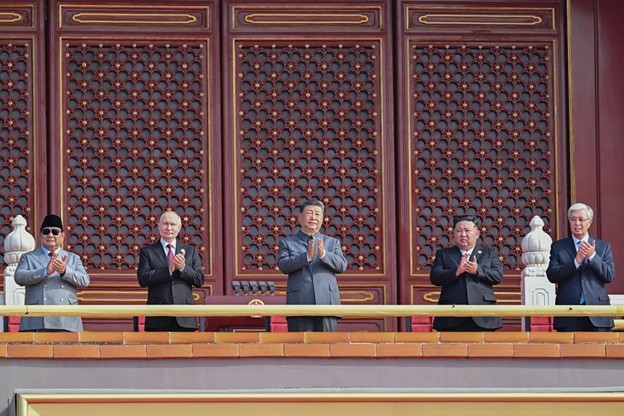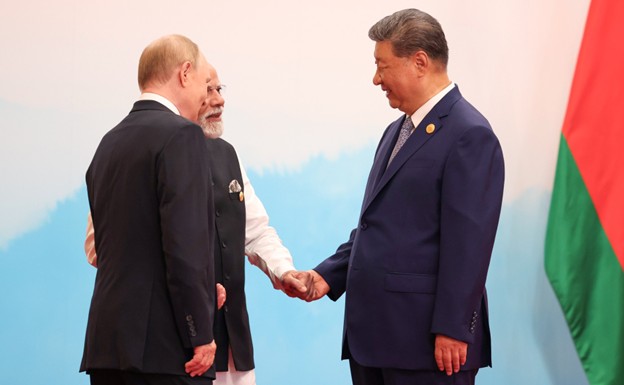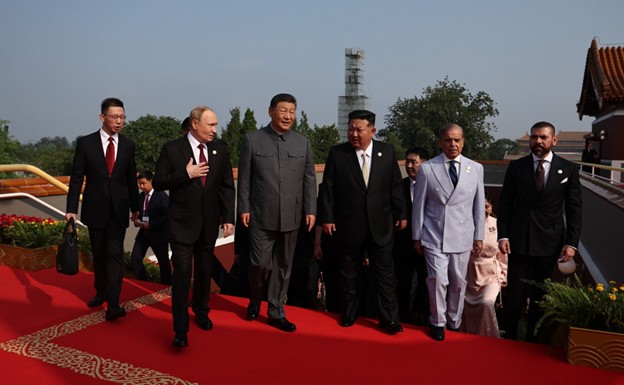
General Secretary of the Chinese Communist Party Xi Jinping, General Secretary of the Workers' Party of Korea Kim Jong Un, and President of the Russian Federation Vladimir Putin — the so-called “axis of upheaval” — alongside President of Kazakhstan Kassym-Jomart Tokayev and President of Indonesia Prabowo Subianto, at China’s Victory Day military parade in Beijing.
Original image: Wikimedia Commons – World leaders attending the 2025 China Victory Day Parade.
The ‘axis of upheaval’ is fast becoming more than a geopolitical catchphrase—it is turning into a lived reality of emboldened political blocs and the growing alignment of non-Western powers. The phrase was first coined by Andrea Kendall-Taylor and Richard Fontaine in an April 2024 Foreign Affairs article. Initially, the axis referred to Iran, China, Russia, and North Korea—nations often at odds with Washington. Today, however, the concept has grown in scope, taking on new meaning in the wake of President Trump’s tariff upheaval.
Washington has already clashed with three of the original axis members: a strike on Iranian nuclear facilities, a trade war with China, and mounting tensions with Moscow over Ukraine. North Korea, meanwhile, remains a longstanding adversary. Against this backdrop, tariff-driven friction is feeding momentum for new bilateral and trilateral alignments across South and East Asia.
Trump’s aggressive tariff measures—tariffs reaching as high as 50% on Indian goods among others—were intended to strengthen U.S. leverage. Instead, they risk alienating partners, eroding trust, and accelerating the very coalitions Washington most fears. India, once seen as a strategic regional partner against China, is edging closer to Moscow and even signalling diplomatic thaw with Beijing. The recent Shanghai Cooperation Organization (SCO) summit in Tianjin underscored this shift, with Indian, Chinese, and Russian leaders openly engaging in dialogue.
Blocs like Brazil, Russia, India, China and South Africa (BRICS) and Association of Southeast Nations (ASEAN) were already pushing initiatives such as local-currency trade and gradual de-dollarization. The tariff upheaval has acted as a catalyst, further encouraging these efforts and amplifying a trend toward economic diversification away from Washington. Rather than tightening U.S. influence, the tariff strategy risks creating a more cohesive counter-bloc for Washington.

President of Russia Vladimir Putin, Prime Minister of India Narendra Modi, and General Secretary of the Chinese Communist Party Xi Jinping at the 2025 Shanghai Cooperation Summit in Tianjin, China.
Photo by Kremlin.ru, licensed under CC BY 4.0 (via Wikimedia Commons)
On March 12 of this year, a joint naval drill involving three heavily sanctioned nations—China, Russia, and Iran—was conducted in the Gulf of Oman, near the strategic Strait of Hormuz. Then, on September 3, the leaders of China, Russia, and North Korea appeared together for the first time at a military parade in Beijing, an event attended by other members of the non-Western bloc, including the heads of state of Iran and Pakistan.

General Secretary Xi Jinping of the Chinese Communist Party and world leaders attending the 2025 China Victory Day Parade in Beijing.
Photo by President of Russia, licensed under CC BY 4.0 (via Wikimedia Commons.)
These developments were not mere displays of symbolism and unity. They marked a shift from mere diplomatic posturing toward genuine security cooperation. For Washington, the signal could not be clearer: its most sanctioned rivals are no longer just staging shows of unity; they are actively learning to operate together on the battlefield and deepening their defence ties in the process.
If such exercises become routine, they will not only demonstrate solidarity but also build real interoperability—enhancing these nations’ capacity to coordinate against U.S. policies. For South Asia, already a region of competing power centers, the rise of this bloc introduces a new layer of strategic complexity.
Trump’s economic nationalism, framed under the banner of “America First,” may resonate politically at home, but its global costs are mounting. Domestically, tariffs on critical imports like semiconductors and electronics have driven up consumer prices, adding strain on households already grappling with inflation.
Internationally, tariffs are doing more harm than good. They are straining long-standing alliances, pushing strategic partners into the arms of rivals, and undermining decades of careful U.S. diplomacy. At the very moment when Washington needs coalitions to address challenges from climate change to supply chain resilience, it risks standing alone.
China has wasted no time in framing this new moment as a turning point. At the SCO summit, President Xi declared that the world had entered “a new phase of turbulence” and that global governance was at “a new crossroad.” Beijing has long criticized U.S. sanctions and tariffs as tools of containment, portraying them as coercive tactics designed to maintain hegemony rather than foster fair competition.
This framing is gaining traction. For many countries in South Asia and beyond, tariffs are not simply an economic measure; they are seen as a political weapon. That perception makes Washington’s partners like India more receptive to alternatives championed by Beijing, Moscow, and others.
Perhaps the most consequential shift lies with India. Long courted as a natural counterbalance to China, New Delhi is now signalling independence in its foreign policy. Rather than bending under U.S. tariff pressure, India is diversifying — deepening energy ties with Russia, engaging more constructively in BRICS, and even exploring conciliatory gestures toward China despite recent tensions.
At the same time, Modi publicly reassured Trump of India’s commitment to a positive relationship, after Trump first speculated on Truth Social that the U.S. might have lost India to China but then downplayed it in a White House statement. Trump’s own words that he will “always be friends with Modi” and that there is “nothing to worry about” signal a desire to steady ties, yet they coexist with India’s strategic hedging — strengthening alternative partnerships while carefully maintaining the U.S. relationship.
For Washington, this is more than a missed opportunity—it is a warning. If the U.S. continues down a path of economic coercion, it may push India further from its orbit, undermining one of the most vital strategic partnerships of the 21st century.
It would be premature to claim a new world order is here. The U.S. still commands unmatched military, economic, and technological advantages. But the direction of travel is clear: the global system is becoming more multipolar, with rising powers less willing to accept terms dictated by a handful of Western capitals.
The so-called ‘axis of upheaval’ may not yet have the structure of a formal alliance, but it is fast becoming a partnership of convenience. What gives it life is not only a shared resistance to Washington but also the openings created by U.S. policies that alienate more than they unite.
Trump may be starting to rethink his tariff war. His recent statements suggest a cautious shift, as Washington balances assertiveness with diplomacy amid growing global competition.
Strategic patience and economic pragmatism could repair strained partnerships. Re-engaging India on cooperation is a natural first step, while supporting reforms in the International Monetary Fund (IMF) and World Trade Organization (WTO) could signal willingness to adapt to a multipolar world. Such adjustments would let the U.S. show flexibility and regain trust with key partners.
America’s strength has long come from consensus, not compulsion. Recognizing that tariffs and sanctions cannot replace strategy, Washington can avoid isolation and position itself again as a partner of choice. Yet the stakes remain high.
The axis of upheaval is not destiny—it is a warning. If U.S. economic statecraft relies on blunt instruments like tariffs, it will accelerate the alignments it fears. But by acknowledging risks, adjusting its approach, and investing trust with key partners, Washington can shape a future where multipolarity need not mean marginalization. Time for recalibration is limited.
The world is watching. The question is whether Washington is willing to adjust before it is too late.
This article examines how the UN Security Council’s veto power...
This article explores the concept of science diplomacy as a...
This article uncovers how the political ascent of Zohran Mamdani...
This article examines how the global silence over Sudan’s humanitarian...
This article examines the way artificial intelligence is transforming global...
This article reexamines the meaning of ASEAN neutrality in light...
This article analyzes the geopolitical and institutional significance of the...
This article examines how deepfakes have evolved from isolated digital...
This article critically examines the evolving contestation of the Responsibility...
This article contends that Trump’s high-value diplomacy in the Gulf...
This article examines how the EU-ASEAN partnership has significantly evolved...
This article examines how President Prabowo Subianto seeks to combine...
This article takes a look at how Prabowo’s UN address...
This article explores how Gulf states, particularly Saudi Arabia and...
This article examines Armenia’s blocked bid to join the Shanghai...
This article examines Indonesia’s recent acquisition of the Turkish-made KHAN...
This article explores how U.S. tariffs, intended to strengthen leverage...
This article explores how the OIC, despite its authority to...
This article examines how the 2025 recognition of Palestine by...
This article shows how the United States’ 19% tariff on...
This article reflects on the Thailand–Cambodia border dispute, capturing it...
This article examines how the absence of coordinated trade negotiations...
This article explores the strategic implications of the Indonesia–Turkey defence...
This article reveals how Hungary, a country that is frequently...
Leave A Comment